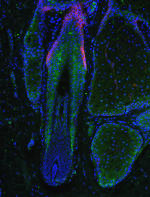
Dr. Bernstein contributed to an article on hair loss genetics published in Huffington Post. In the article, “Sorry, You Can’t Just Blame Your Mother’s Father for Your Thinning Hair” Dr. Bernstein addresses the common myth that hair loss is inherited exclusively from the mother’s side of the family – and, more specifically, from your mother’s father. While your mother’s (or maternal grandfather’s) genes can be the culprit, the characteristics of your hair are influenced by many different genes that may come from either or both sides of your family.
The confusion stems from the fact that men inherit their X chromosome from their mother and a key gene involved in hair loss is found on the X chromosome.
Dr. Bernstein explains:
The androgen receptor gene is an X-linked gene, so there’s a slightly greater incidence of it following the mother’s side of the family than the father’s side, but genetic hair loss is polygenetic and the expressivity is very variable, so both sides can contribute to someone’s hair loss.
Dr. Christopher Cunniff, a clinical geneticist at Weill Cornell Medicine and New York-Presbyterian Hospital, added a comment that the genes most clearly identified as having influence on hair texture or color have not been found to be located on the X chromosome.
The article discusses hair loss genetics and a range of factors affecting the characteristics of one’s hair.
- Read more about Hair Loss Genetics
- Read posts about Hair Loss Genetics on the Bernstein Medical Blog
- Read more about Research in the field of Hair Loss Genetics
Image c/o: Ruigsantos via Getty Images
Posted by


 Hair transplant surgeon Robert M. Bernstein M.D. was recently interviewed on the National Public Radio program The People’s Pharmacy. Invited to speak about hair loss, Dr. Bernstein offered insights about the causes of hereditary baldness and it’s solutions, including hair transplantation.
Hair transplant surgeon Robert M. Bernstein M.D. was recently interviewed on the National Public Radio program The People’s Pharmacy. Invited to speak about hair loss, Dr. Bernstein offered insights about the causes of hereditary baldness and it’s solutions, including hair transplantation.



